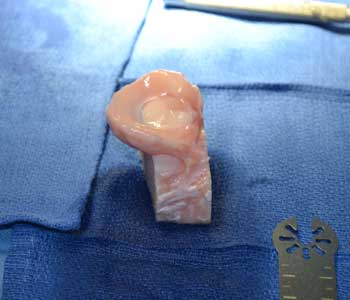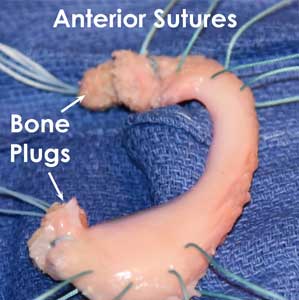Meniscal Transplant
What is a meniscal transplant?
A meniscal transplant is a technically challenging procedure that is available to patients who have failed a prior meniscal repair and subsequently underwent a total meniscectomy. These patients are typically followed closely for the rapid development of osteoarthritis and are offered meniscal replacement to preserve their joint health. The goal of a meniscal transplant is to restore proper function and structure to a knee that has lost its native meniscus. This will allow for improved shock absorption within the knee and an improved fit between the bones of the knee.

Who is a candidate for a meniscal transplant?
It is typically indicated for younger patients who have undergone a total meniscectomy and continued to have symptoms that are affecting their quality of life or ability to perform the activities of daily living. These patients must fail to have an adequate improvement with non-operative management before a meniscus transplant can be recommended. Patients with extensive cartilage damage are also poor candidates for the procedure as there will be difficulty in placing the transplanted meniscus due to the reduced joint space associated with an arthritic joint. Other typical drawbacks and limitations from meniscal transplant are similar to transplants of other organs: there is always an inherent immunologic risk, a limited risk of disease transmission, and limited donor availability.
What are the surgical steps of a meniscal transplant?
If a patient elects to proceed with a meniscal transplant, they will have preoperative imaging to allow for proper sizing. When a size matched and immunologically matched graft is available, the patient will be scheduled for surgery. During the procedure, an incision is made alongside the patellar tendon to allow for insertion of the meniscal allograft. The meniscal graft can be secured using a variety of techniques including a bone plug technique and a bone fixation technique. Currently, there is no evidence to suggest one technique is superior to the other.

What is the postoperative rehabilitation like?
Among the rehabilitation regimens after a meniscal surgery, rehabilitation for a meniscal transplant is the strictest. The transplanted meniscus needs to be allowed a generous amount of time to integrate with the surrounding tissue. Failure to adhere to the strict rehabilitation regimen could lead to the ultimate failure of the surgical intervention. For the first 6 weeks, the patient is required to use a knee immobilizer and maintain a strict non-weight bearing with crutches. From 6-8 weeks, the patient will begin weight bearing and progress to full weight bearing. They will continue to have a restricted range of motion until 8 weeks. By 12 weeks, they can begin higher strain functional activities including lunges.
Here at Midwest Orthopaedics at Rush in Chicago, Dr. Chahla and his team of physical therapists design and carefully structure rehabilitation to advance patients based on milestones. This allows patients to advance when they are functionally ready rather than at non-specific set time points. The major goal is to restore daily function and pain free living.
Dr. Chahla is a nationally renowned, award-winning, fellowship-trained, and board-certified orthopedic surgery in Chicago. Dr. Chahla has orthopedic clinics in Chicago, Naperville, Oak Brook, and Munster Indiana.
At a Glance
Dr. Jorge Chahla
- Triple fellowship-trained sports medicine surgeon
- Performs over 500 surgeries per year
- Assistant professor of orthopedic surgery at Rush University
- Learn more


